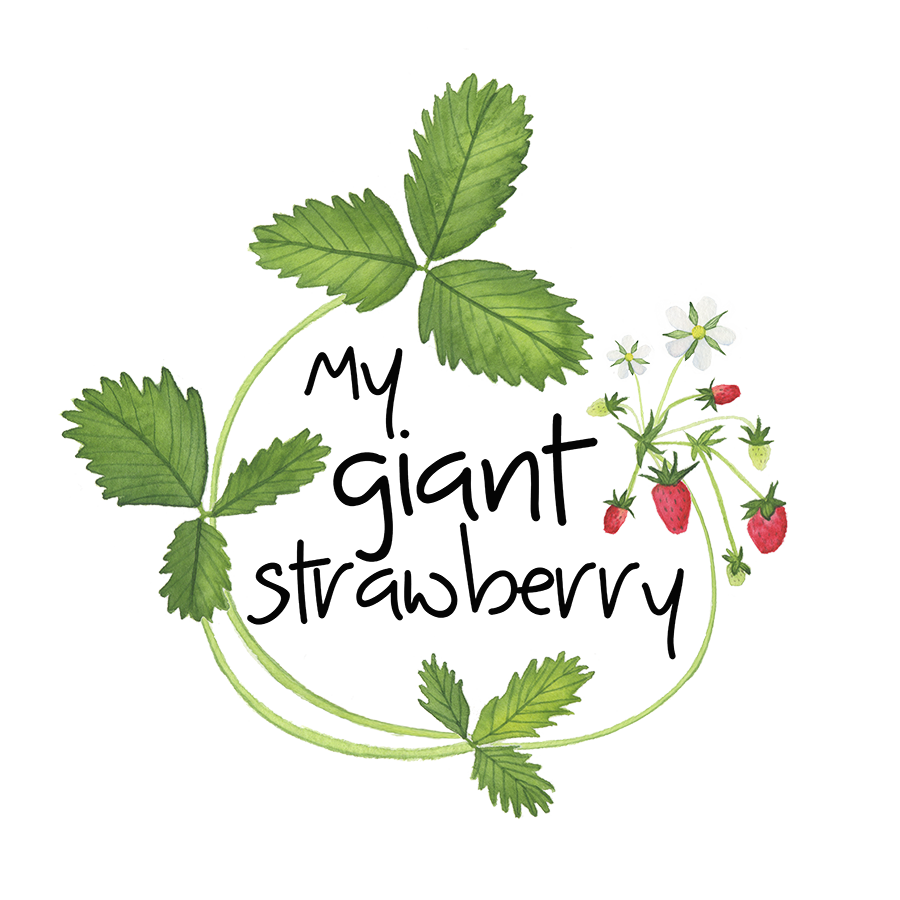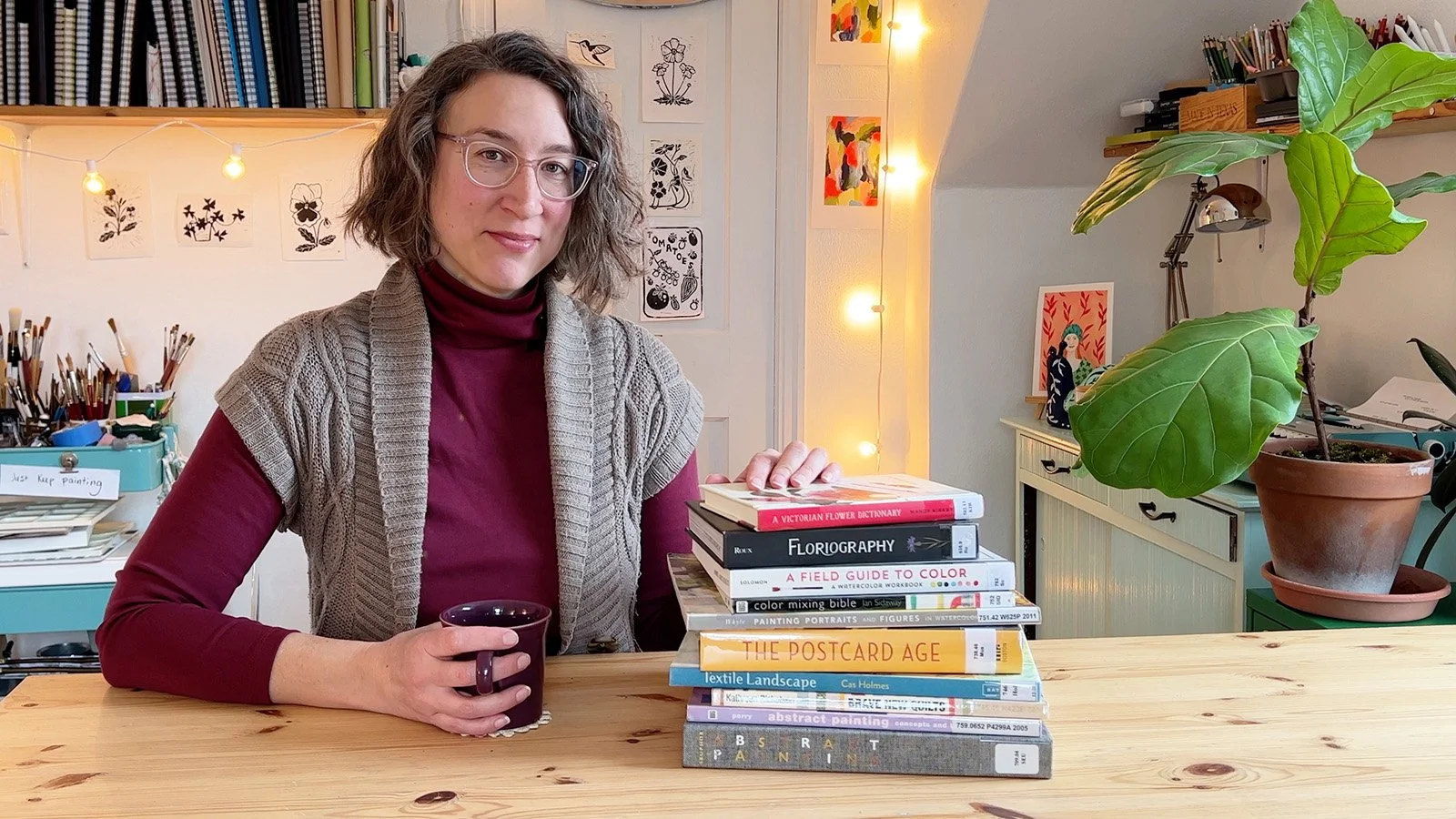Why I Love the Library: a Review of 10 Books Inspiring Me Right Now
Last week I mentioned how books are one of the ways I make it through the winter. And over the years I’ve shared books here on my blog again and again.
Books are my constant companions and although I have a lot of my own books, I also regularly take home piles of books from the public library.
You may know that I was a librarian before I was an artist (I even have a master’s degree in library and information science!), but I’ve always loved the library. Even when I was a little child I’d go with my parents to ours (animal books were some of my favorites to check out). The first place I drove by myself after getting my driver’s license was the library. And as an adult one of the first things I’ve done each time I’ve moved is to get my library card.
When I first started learning how to paint, I turned to books to teach me. Sadly, I was disappointed. I couldn’t find any that showed me how to paint the way I imagined in my head. I think part of it was that I wasn’t looking at the right books and part is that learning to paint is really about painting. Doing the work, not reading a book.
Even so, books are wonderful for creative inspiration. I turn to them when I’m curious about a topic and want to dive deep into research. Or when I want to study different styles of art and different perspectives. Or if I just want to look at beautiful pictures, savoring color and imagery.
Sometimes a few minutes paging through a book is enough to buck me out of a crabby mood or help me shake off a creative block.
Today I thought I’d share some of my current stack of library books.
A Victorian Flower Dictionary by Mandy Kirkby
This book is a companion to Vanessa Diffenbaugh’s novel The Language of Flowers (a wonderful book if you haven’t read it). After the beautiful cover, the interior flower illustrations are a bit disappointing, but it’s filled with interesting information. 50 flowers are featured with full entries and more are included in the dictionary at the back of the book.
Floriography: An Illustrated Guide to the Victorian Language of Flowers by Jessica Roux
This book is gorgeous, from the endpapers to the paintings for each flower entry to the illustrations of meaningful bouquets. The entries are shorter than in Mandy Kirkby’s book, but the book still provides plenty of information. (Be sure to check out Jessica Roux’s website to see more of her beautiful work).
There are many more books on this topic and I’m looking forward to continuing to explore them as they arrive from the library for me.
A Field Guide to Color: A Watercolor Workbook by Lisa Solomon
I was surprised my library system owned a copy of this workbook because it truly is a workbook, with many pages intended for your own painting experiments. It would be the perfect book for someone who is just getting started with watercolor and wants to learn about color mixing. Just looking through it made me want to pick up my paints.
Lisa Solomon is an inspiring artist (I’ve taken a few of her classes on Creativebug. Check with your library to see if they have a subscription you can use).
Color Mixing Bible by Ian Sidaway
Color mixing is one of my favorite parts of the painting process and this book made me so happy. It starts with information about art materials, the science of color and color theory. Then it is filled with charts outlining mixes of different colors in oil, acrylic, watercolor, gouache, soft pastel, ink and colored pencil. I love these charts!
It’s not exhaustive (no book could be) and some colors aren’t included (very few pinks are mentioned), but it would be a great reference book for any artist, especially a beginner. What I found most interesting was mixing colors I wouldn’t have thought to combine. It’s made me want to play and experiment.
Painting Portraits and Figures in Watercolor by Mary Whyte
I hadn’t heard of Mary Whyte before checking out this book. Her work is amazing (be sure to pop over to her website to learn more — and don’t miss her video about her We The People project. I placed a hold on the book and am looking forward to looking at it); the cover of this book doesn’t really do it justice. If you’re a beginner with no art experience and you want to learn to paint people, I don’t think this book will get you there. But it is filled with beautiful art and a wealth of knowledge. There are a few sections of “demonstrations” where multiple photos of the painting process are included, but none of them really outline a start-to-finish painting in a way that could be replicated.
The Postcard Age: Selections from the Leonard A. Lauder Collection by Lynda Klich and Benjamin Weiss
A wonderful collection of vintage postcards from the Museum of Fine Arts in Boston (almost 400 are included in the book and the museum’s entire collection, searchable online, includes around 130,000 postcards). It’s historically fascinating and the art is fun to study for color, composition and stylistic inspiration.
Textile Landscape: Painting with Cloth and Mixed Media by Cas Holmes
When you pick up this book, you can’t help but want to open it. The velvety fabric cover is irresistible. The inside is just as appealing, filled with art by many textile artists with different styles and favorite materials. Embroidery, printmaking, quilts, stitched books, 3-D work…
I had to look up the author and became fascinated with her work (don’t miss her website or her blog!). I’ve placed holds on more of her books, too. I love how one thing leads to another with books and the library.
Brave New Quilts: 12 Projects Inspired by 20th Century Art From Art Nouveau to Punk & Pop by Kathreen Ricketson
Quilts inspired by art movements? What a cool idea. This is a book of quilting projects, but I loved looking through it for color and composition inspiration even though I have no intention of making any of the quilts. I especially enjoyed the photos of the artist’s process (including her sketches) and the “design your own” alternate color sketch examples after each project (perhaps even more than the quilts themselves).
(After reading the book I looked up Kathreen Ricketson and was shocked to learn that she and her husband died in a swimming accident while on vacation with their two children).
Abstract Painting: Concepts and Techniques by Vicky Perry
Many of the abstract paintings in this book resemble quilts! Perhaps after looking through a quilting book this was even more apparent to me. This is a great introduction to abstract painting and is filled with many examples by many different artists working in different styles and media. It’s not a how-to book, but it is geared toward the artist wanting to experiment with abstract art, outlining materials and techniques and the feelings behind creating artwork.
Abstract Painting: Fifty Years of Accomplishment from Kandinsky to the Present by Michel Seuphor
This last book is a history of abstract painting, though I checked it out just to look at the art. It is filled with paintings from many artists and I imagined looking at it as virtually visiting a museum (something I can’t do very often living where I do).
(Having recently watched the documentary Beyond the Visible about Hilma af Klint, I did wonder how much of the history of abstract painting has been left out of books like this).
Want to take a look inside the books? I’ve created a video review so we can look through them together:













